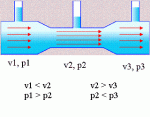Needsajet,
I agree with our comments re. filter head loss and Venturi effect.
in reality most loss occurs before the T.
the water level rises ~40mm with each 50rpm increment, and pressure rises approximately 3kPa
I agree with our comments re. filter head loss and Venturi effect.
in reality most loss occurs before the T.
the water level rises ~40mm with each 50rpm increment, and pressure rises approximately 3kPa


